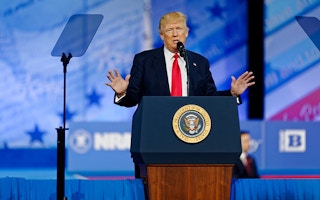Despite the Trump administration’s decision to withdraw the official estimate of the Social Cost of Carbon and disband the interagency working group that developed it, a group of prominent economists and lawyers have highlighted the metric’s continued validity for policymaking.
In a letter published on August 18 in the journal Science (archived PDF here), the group takes on key criticisms surrounding the metric, which quantifies the economic costs of carbon dioxide emissions and is used when assessing the costs and benefits of regulations.
The letter encourages both government and private-sector analysts to continue using the interagency working group’s Social Cost of Carbon estimate.
Through an executive order issued in March, President Trump instructed federal agencies to individually monetise climate damages rather than use the existing central estimate of $50 per ton of carbon dioxide.
But the Science letter forcefully argues that the existing estimates are in fact the best available, reflecting peer-reviewed scientific and economic models. The economic analyses that underlie numerous state and federal policies make use of the interagency working group’s Social Cost of Carbon, and the letter suggests that the metric remains appropriate in these contexts.
Among the authors of the letter were Richard Revesz, professor and dean emeritus at New York University School of Law and director of the Institute for Policy Integrity, and several researchers at the Institute. Michael Greenstone, the Milton Friedman Professor in Economics and director of the Energy Policy Institute at the University of Chicago, was one of several leading economists who authored the letter. Greenstone co-led the original development of the working group under President Obama.
The executive order asked agencies to specifically reconsider two elements of the Social Cost of Carbon: the discount rates and domestic versus international impacts. However, the authors write that “scientists and economists widely endorse” the methodological choices made by the interagency working group.
For the discount rate—that is, the factor for converting future costs and benefits into present-day values—the working group applied values ranging from 2.5 per cent to 5 per cent, with a central estimate of 3 per cent.
Critics say those rates are too low, and that a higher rate, like 7 per cent, should be used. Choosing a higher rate would place less value on avoiding future damages and impose higher costs on future generations, and a higher rate has little to no support in the economic literature or in surveys of expert economists.
Further, the authors write that the “National Academies of Sciences and the US Council of Economic Advisers strongly support a 3 per cent or lower discount rate for intergenerational effects. A 7 per cent rate based on private capital returns is considered inappropriate because the risk profiles of climate effects differ from private investments.”
On the topic of domestic versus international impacts, critics argue that the estimate should not take into account damages that occur beyond US borders. However, climate change is a global phenomenon.
Just as US emissions contribute to global damages, each ton of carbon emitted outside the United States inflicts damages on this country. Thus, the authors write that estimating the global damages of US emissions reinforces “reciprocal climate policies in other countries.” Additionally, the authors note that “current models cannot accurately estimate a domestic-only share of the social cost of greenhouse gases.”
While the letter clearly states that the “social cost of greenhouse gases should be regularly updated, especially to reflect the latest evidence about damage functions,” the authors argue that the government and private sector should continue using the working group’s central estimate “with confidence that it is still the best estimate of the social cost of greenhouse gases.”
Along with Revesz and Greenstone, the letter was written by Michael Hanemann, a professor of environmental and resource economics at the University of California–Berkeley; Thomas Sterner, a professor of environmental economics at the University of Gothenburg in Sweden; Michael Livermore, a professor at the University of Virginia School of Law; Jason Schwartz, the legal director of the Institute for Policy Integrity at NYU School of Law; Peter Howard, the Institute’s economics director; and Denise Grab, a senior attorney at the Institute.
The letter is available at: http://science.sciencemag.org/content/357/6352/655
An archived PDF of the letter is available at: http://policyintegrity.org/documents/Science_Revesz_et_al_081718.pdf

















